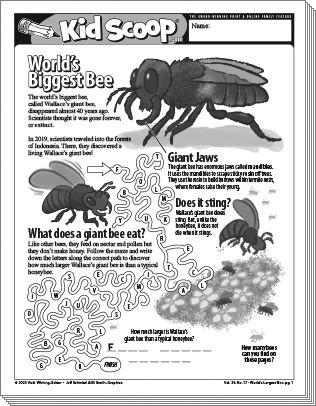 With over 20,000 known species of bees in the world, how do scientists distinguish one from another? Is it color, shape, stinger, or wings? One way to identify bees is by size, and only one species of bee flies head and shoulders above the rest. Wallace’s giant bee—several times larger than the average bee—boasts enormous jaws and an impressive wing span to help it survive in the forests of three small islands in Indonesia. No one is quite sure where Wallace’s giant bee came from, or why it grew so large, but this giant bee has been gathering pollen and nectar to feed its young for a long time while leaving honey-making to the smaller honeybees. Despite its impressive size and features, Wallace’s giant bee is still considered “vulnerable” to extinction. Learn more about this giant bee that has the world of science buzzing!
With over 20,000 known species of bees in the world, how do scientists distinguish one from another? Is it color, shape, stinger, or wings? One way to identify bees is by size, and only one species of bee flies head and shoulders above the rest. Wallace’s giant bee—several times larger than the average bee—boasts enormous jaws and an impressive wing span to help it survive in the forests of three small islands in Indonesia. No one is quite sure where Wallace’s giant bee came from, or why it grew so large, but this giant bee has been gathering pollen and nectar to feed its young for a long time while leaving honey-making to the smaller honeybees. Despite its impressive size and features, Wallace’s giant bee is still considered “vulnerable” to extinction. Learn more about this giant bee that has the world of science buzzing!
In this issue students will:
- read informational text about the Wallace giant bee
- learn about bee habits and structures that aid in survival
- use codes to decipher bee facts
- unscramble letters to comprehend facts about the world’s smallest bee
- calculate sums and differences to total a precise amount
- practice comparative and superlative adjectives
- write creatively from a bee’s point of view
- locate and evaluate newspaper articles about endangered species
7 page PDF
